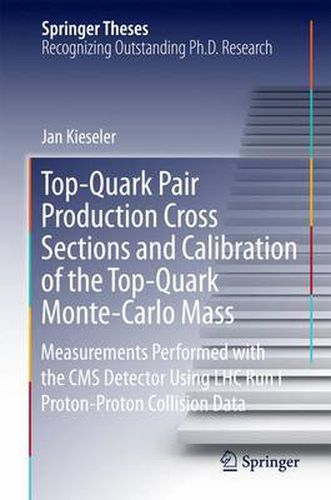Readings Newsletter
Become a Readings Member to make your shopping experience even easier.
Sign in or sign up for free!
You’re not far away from qualifying for FREE standard shipping within Australia
You’ve qualified for FREE standard shipping within Australia
The cart is loading…






This title is printed to order. This book may have been self-published. If so, we cannot guarantee the quality of the content. In the main most books will have gone through the editing process however some may not. We therefore suggest that you be aware of this before ordering this book. If in doubt check either the author or publisher’s details as we are unable to accept any returns unless they are faulty. Please contact us if you have any questions.
This thesis presents the first experimental calibration of the top-quark Monte-Carlo mass. It also provides the top-quark mass-independent and most precise top-quark pair production cross-section measurement to date. The most precise measurements of the top-quark mass obtain the top-quark mass parameter (Monte-Carlo mass) used in simulations, which are partially based on heuristic models. Its interpretation in terms of mass parameters used in theoretical calculations, e.g. a running or a pole mass, has been a long-standing open problem with far-reaching implications beyond particle physics, even affecting conclusions on the stability of the vacuum state of our universe. In this thesis, this problem is solved experimentally in three steps using data obtained with the compact muon solenoid (CMS) detector. The most precise top-quark pair production cross-section measurements to date are performed. The Monte-Carlo mass is determined and a new method for extracting the top-quark mass from theoretical calculations is presented. Lastly, the top-quark production cross-sections are obtained - for the first time - without residual dependence on the top-quark mass, are interpreted using theoretical calculations to determine the top-quark running- and pole mass with unprecedented precision, and are fully consistently compared with the simultaneously obtained top-quark Monte-Carlo mass.
$9.00 standard shipping within Australia
FREE standard shipping within Australia for orders over $100.00
Express & International shipping calculated at checkout
This title is printed to order. This book may have been self-published. If so, we cannot guarantee the quality of the content. In the main most books will have gone through the editing process however some may not. We therefore suggest that you be aware of this before ordering this book. If in doubt check either the author or publisher’s details as we are unable to accept any returns unless they are faulty. Please contact us if you have any questions.
This thesis presents the first experimental calibration of the top-quark Monte-Carlo mass. It also provides the top-quark mass-independent and most precise top-quark pair production cross-section measurement to date. The most precise measurements of the top-quark mass obtain the top-quark mass parameter (Monte-Carlo mass) used in simulations, which are partially based on heuristic models. Its interpretation in terms of mass parameters used in theoretical calculations, e.g. a running or a pole mass, has been a long-standing open problem with far-reaching implications beyond particle physics, even affecting conclusions on the stability of the vacuum state of our universe. In this thesis, this problem is solved experimentally in three steps using data obtained with the compact muon solenoid (CMS) detector. The most precise top-quark pair production cross-section measurements to date are performed. The Monte-Carlo mass is determined and a new method for extracting the top-quark mass from theoretical calculations is presented. Lastly, the top-quark production cross-sections are obtained - for the first time - without residual dependence on the top-quark mass, are interpreted using theoretical calculations to determine the top-quark running- and pole mass with unprecedented precision, and are fully consistently compared with the simultaneously obtained top-quark Monte-Carlo mass.